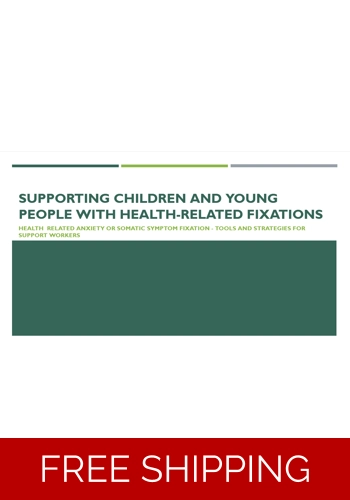Health Related Fixations - Supporting Young People and Children
Supporting Young People and Children with Health Related Fixations
Health Related Anxiety or Somatic Symptom Fixation
Awareness, Tools and Strategies for Support Workers
Enough resources for full sessions, single aspects or a one day course with workshops.
All editable.
14 Files in total (Presentation (in sections) , Handouts x 4, Learning Activity documents x 7 and End of Session Assessment with Trainer Aide Answer Key.
Aims and Objectives:
Overall Aim: To equip support workers with the knowledge and skills to respond effectively and compassionately to young people who hold inaccurate beliefs about their health, while promoting emotional well-being and psychological flexibility.
Learning Objectives:
Understand why children/young people may believe they have medical conditions they don't have
Learn how to respond empathetically without reinforcing false beliefs
Gain practical strategies to support emotional regulation and resilience
Know when and how to involve clinical professionals
Presentation (84 Slides)
Aims and Objectives
Welcome
Objectives of the Training
Section - Understanding the Young Person's Experience
Health Anxiety
Factitious Disorder
General Anxiety Disorder
How they Overlap and Differ
Why This Matters for Support Workers
How Beliefs about Illness can Serve as a Coping Mechanism
Common Ways Illness Beliefs Become a Coping Mechanism
Why it Matters
The Role of Attention Needs, Trauma and Control Issues
Trauma
Attention Needs
Control Issues
In Summary
Why This Matters for Support Workers
The Impact of Internet and Social Media on Health Beliefs in Children and Young People
Exposure to Misinformation and Self-Diagnosis
Reinforcement of Health Anxiety and Symptom Checking
Online Communities: Supporting or Harmful?
Illness as an Identity
Difficulty Discerning Reliable Sources
Support Workers
In Summary
Section - Do's and Don'ts
Acknowledge Feelings Without Validating False Beliefs
Use Calm, Non Confrontational Language
Focus on Emotional Support, Not Symptom Investigation
Redirect to Trusted Medical Authority When Needed
Don'ts - What Can Worsen the Situation
Don't Provide Excessive Reassurance
Don't Allow Obsessional Checking or Symptom Discussion to Dominate
In Summary
Section - The Power of Validation and Boundaries
Validate Emotions Without Endorsing Inaccurate Beliefs
What You Can Say
The Role of Phrases
Setting Compassionate Limits on Discussions about Symptoms
What You Can Do
In Summary
Section - Building Psychological Flexibility
What is Psychological Flexibility?
Encouragement of Exploration of Multiple Interpretations of Symptoms
Use Curiosity
Introduce Simplified CBT Tools
use of Mindfulness and Grounding Activities to Manage Anxiety
In Summary
Section - Collaborating with Professionals
When to Escalate
How to Escalate
Importance of Consistent Messaging from All Adults
Multi Agency Working and Safeguarding Considerations
In Summary
Section - Self Care for Staff
Impact of Working with High Anxiety or Resistant Young People
Emotional Boundaries
Debriefing
Support Networks and Supervision
In Summary
Section - Key Takeaways and Next Steps
Key Takeaways
Next Steps
References
Word Documents
4 x Handouts
7 x Learning Activities
End of Session Assessment (mix of multiple choice, True/False and Short Answer)
Trainer Aide Answer Key
HSC Training Link
Training Resources for Health and Social Care
Supplying training resources for the health and social care sector since 2004.
Resources purchased are emailed to you via Zip Folder attachment.
All packs are written in a generic style and can easily be adapted to suit your own specific training delivery.
Secure payments via PayPal Merchant Commerce Platform.
You do not need a PayPal account to use this payment
gateway.
Debit and credit card payments accepted.


